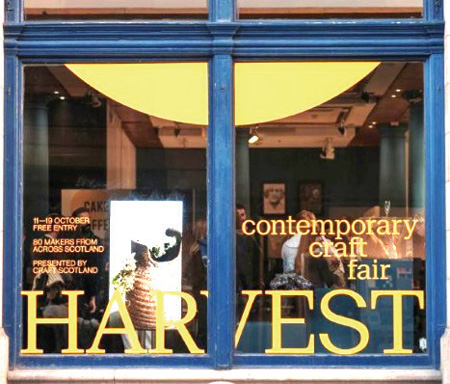
Harvest time at Edinburgh's City Art Centre
Tessa Williams talks to Dr Stacey Hunter, curator of the recent Craft Scotland Contemporary Craft Fair

SCOTLAND'S CRAFT world got a big boost this autumn with the inauguration of HARVEST – A feast for the senses,a sparkling craft design show on the fourth floor of the City Arts Centre in Edinburgh, attracting more than 8000 visitors and showing the work of eighty independent Scottish craft makers, the event garnered much local interest as well as internationally to buyers.
Curated by former jewellery designer and Duncan of Jordanstone graduate, the irrepressible Dr Stacey Hunter, it brought a new level of interest to many crafts and styles that are resolutely Scottish in heritage.

Chatting with Stacey just as she wrapped up the show in Edinburgh, it was fascinating to hear how she managed to put it all together in such a short time.
"I had a conversation with Irene Kernan (the head of Craft Scotland) in February, and we took it from there.
"I always felt there was the need for a new platform or a way for independent curators to show their work. Ever since 2020 this notion of conviviality had been playing over in my mind, I had wanted to do a big show with that at the centre of it – and the craft world epitomises this.
"The way it crosses over with our human desire to break bread with one another. How that also – also the idea for us as buyers of craft, how does one decide what objects to place on the table when you invite people over to dine with you? You take a lot of care what you dress the table with. I wanted to really lean in to that and show what people wanted to show for their own homes," she explained.

Having studied at Duncan of Jordanstone, in Dundee, followed later by a PhD at the University of Edinburgh's School of Architecture, where she focused on design culture, urbanism, and the built environment, Stacey has travelled extensively in her career.
"After I graduated I lived in Hamburg for a while, doing some research – when I was finishing my degree I had won a travel prize to research at a German electronic company – I was interested in lighting design in my final year – quite quickly after that I got a job at the Lighthouse in Glasgow which was where my interest in public programming began" she explained.
Her work has also taken her to Japan, "I was selected as a curator for the Tokyo Olympics as some curators from Japan came over to Scotland and offered to help to do an open call here in Scotland. It was marvellous, I had two whole months there, one month in Tokyo and one in a very small porcelain making town. It was a brilliant experience to have there!" she enthused.
Stacey has also enjpyed success on earlier curating projects in Scotland – Local Heroes which showed design work at Edinburgh airport and in the Merchant City, as well as collaborating with New York Jewellery week on a digital exhibition showcasing more Scottish designers.
Harvest took over one floor – the fourth floor – of the City Arts Centre for eleven days.
"It's my favourite floor of the City Arts Centre with its 250 square metres of space, and beautiful arched windows, it's the perfect size .
"The City Art Centre as a building, was really the starting point for the concept of Harvest. This building has always inspired me. Since it began life as the Scotsman building. A newspaper building to begin with and then later, when the Waverley station was established and the fruit market was taken from what's currently Waverley and moved to Market Street – the building became a fruit and vegetable warehouse .Then in 1980 the city architects converted it into custom built exhibition gallery space.
"I was thinking of how it is like a trading post, first of newspapers and ideas, then food and then a market, it really inspired me, also I loved the Idea of the harvest time, it is a unique time for Scottish creators and harvesters," she added.
"We issued an open call, we didn't charge anyone to apply – the open call went out and we were overwhelmed by the response. In fact we had to call in help from others to whittle it down," Stacey added.
"Who knows yet whether it could in future be a yearly event. It would lend itself well. What we have created is a really valuable brand. I don't know any specifics, but certainly there will be another Harvest," she concluded.








